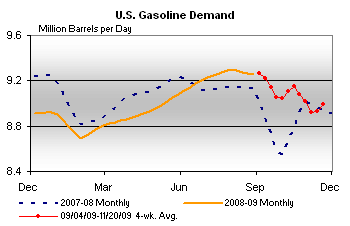 U.S. ethanol policy embodies all the classic conflicts between politics and economics. This morning’s New York Times signals that Congress’s mandate on refiners to use 12.6 billion gallons of ethanol in 2011 will be “mathematically impossible.” When Congress passed the Energy Independence and Security Act of 2007, it assumed gasoline consumption would keep rising, but the recession and auto fuel economy improvements have leveled gasoline consumption as the chart of the Energy Department shows.
U.S. ethanol policy embodies all the classic conflicts between politics and economics. This morning’s New York Times signals that Congress’s mandate on refiners to use 12.6 billion gallons of ethanol in 2011 will be “mathematically impossible.” When Congress passed the Energy Independence and Security Act of 2007, it assumed gasoline consumption would keep rising, but the recession and auto fuel economy improvements have leveled gasoline consumption as the chart of the Energy Department shows.
Next week, the Environmental Protection Agency is expected to choose from three options to resolve this impossibility:
- Raise the current 10% ethanol blend rate;
- Waive the ethanol “Renewable Fuel Standard;” or
- Postpone the decision awaiting further study.
Option 1 would enrage auto manufacturers and owners who may experience catalytic converter failures around 50,000 miles rather than between 120,000 and 150,000 miles currently because of higher operating temperatures caused by higher ethanol content. Auto warranties may be voided by this option, creating a field day for lawyers who maintain their stranglehold on the Democratic Party.
Option 2 would enrage mid-Western corn farmers who depend on current production of 7.2 billion gallons of ethanol and another 6.2 billion gallons of capacity under construction in response to the RFS and associated subsidies of the 2005 and 2007 Acts. See this Energy Department link for the history. Recall that the 2008 Iowa primary election launched Barack Obama on his way to the White House.
Option 3 would please neither car owners nor ethanol producers, but it would temporarily avoid the impending political backlash from both. The cynic in me says, this is the likely outcome next week.
President Obama responded to 15 reporters on March 12, 2009 on this choice as follows:
Q: The biofuels. As you probably know, your Agriculture Secretary is joining the ethanol industry and calling on the EPA to do an immediate increase in the ethanol limit to 12 or 13 percent, in advance of doing a higher 15 or 20 percent. Engine manufacturers, the automakers have been opposed to this. What is your position? Are you going to get involved in this decision by EPA?
THE PRESIDENT: At some point I usually get involved. If it — somebody explained to me that nothing comes to my desk if it’s easy. (Laughter.) It means that somebody else has solved it. And I suspect that this one will be reconciling a lot of different issues.
As you know, I’ve been a supporter of biofuels. I think it is an important ingredient in our overall energy independence. I’ve also said — and I said during the campaign trail in Iowa, in front of farmers — that it was important for us to transition to the next generation of biofuels, that we’ve got to do a much better job of developing cellulosic ethanol, that corn-based ethanol, over time, is not going to provide us with the energy-efficient solutions that are needed.
And I want to make sure, though, as somebody who comes from a corn-growing state, that the progress that we’ve made in building up a biofuels infrastructure and the important income generation that has come from ethanol plants, that that is sustained, that that’s maintained.
So our challenge, I think, is to see our current ethanol technology as a bridge to the biofuels technologies of the future. And that’s what we want to invest in, and that’s what I’ll be directing my Department of Agriculture to focus on.
You can interpret this attempt at finding some wiggle room as well as I can.
In my Capitol Hill experience, lawyers tend not to accept the constraints that seem incontrovertible to economists. Sometime soon, possibly next week, EPA’s decision will provide further evidence on this proposition.
Chart: EIA
- Bulenox: Get 45% to 91% OFF ... Use Discount Code: UNO
- Risk Our Money Not Yours | Get 50% to 90% OFF ... Use Discount Code: MMBVBKSM
Disclaimer: This page contains affiliate links. If you choose to make a purchase after clicking a link, we may receive a commission at no additional cost to you. Thank you for your support!


Current ethanol production is near 11.5 billion gallons on an annualized basis with industry capacity of 13 billion and another 1 billion still under construction.